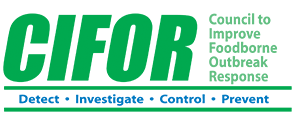History of CIFOR
The Council to Improve Foodborne Outbreak Response (CIFOR) was convened to increase nationwide collaboration across relevant areas of expertise with a vision of reducing the burden foodborne illness in the United States. The CIFOR mission is to improve methods at the local, state, and federal levels to detect, investigate, control, and prevent foodborne disease outbreaks. This is accomplished by identifying barriers to the rapid detection and response to foodborne disease outbreaks and then finding way to address them. CIFOR creates guidelines and tools to facilitate investigation and control of foodborne outbreaks.
Discussions took place between federal, state and local officials in the late 90s and early 2000s about forming a collaboration to improve local and state capacity. The Enteric Disease Investigation Timeline project or EDITS in 2003 was one of the first attempts at quantifying the timeline of enteric disease surveillance and investigation processes at the state level. Building on EDITS, CDC convened a large meeting of stakeholders in Atlanta in March of 2004. The interest in collaboration demonstrated at this meeting led to further discussions at the first OutbreakNet/PulseNet Meeting in Seattle in May 2005 and to formation of a steering committee that met in October 2005. The steering committee included members from the following entities:
Centers for Disease Control and Prevention (CDC)
Council of State and Territorial Epidemiologists (CSTE)
National Association of County and City Health Officials (NACCHO)
National Environmental Health Association (NEHA)
CIFOR had its first official meeting in January 2006 in San Diego. By this time, new members had joined, including the following associations and agencies:
Association of Food and Drug Officials (AFDO)
Association of Public Health Laboratories (APHL)
Association of State and Territorial Health Officials (ASTHO)
Food and Drug Administration (FDA)
Food Safety and Inspection Service (FSIS)/United States Department of Agriculture (USDA)
CIFOR continues to foster relationships with local, state, and federal partners to reduce foodborne illness. New members include the following:
National Association of State Departments of Agriculture (NASDA)
National Association of State Public Health Veterinarians (NASPHV)
From the start, CIFOR’s priority was to develop comprehensive guidelines, The Guidelines for Foodborne Disease Outbreak Response (CIFOR Guidelines), published in 2009, have three major purposes:
- To help local and state agencies examine and improve how they respond to outbreaks
- To provide a foundational reference for anyone working in food safety, particularly new staff
- To harmonize outbreak investigation across agencies, in order to have consistency between jurisdictions
Published in 2011, the CIFOR Guidelines Toolkit helps state and local health departments use the CIFOR Guidelines, assess their outbreak detection and investigation procedures, and implement recommendations. The Toolkit divides the entire range of surveillance and response activities into 11 “Focus Areas” and walks public health practitioners through a series of worksheets designed to help jurisdictions identify areas that need improvement and to provide CIFOR recommendations to address those needs.
CIFOR revised the Guidelines in 2020 and the Toolkit in 2023. These and other CIFOR products are available at CIFOR products.
CIFOR has also established a close working relationship with the food industry, which has primary responsibility for food safety. The CIFOR Industry Workgroup developed the Foodborne Illness Response Guidelines for Owners, Operators and Managers of Food Establishments. It facilitates the food industry’s response to outbreaks within a facility.
